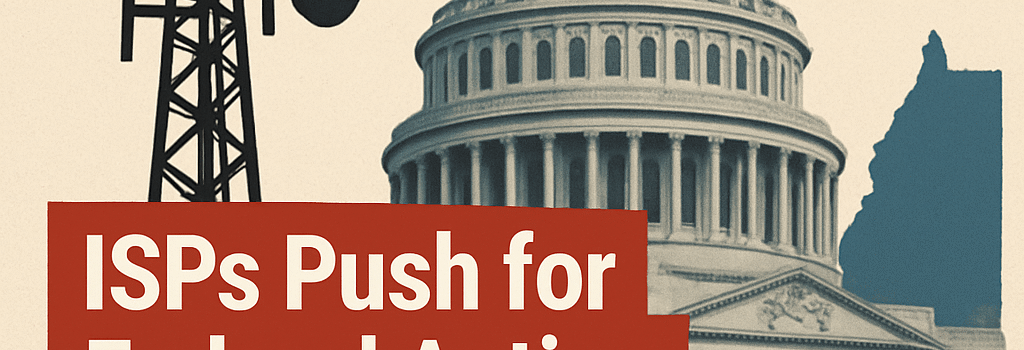ISPs Push for Federal Action Against State Broadband Mandates

After the Supreme Court declined to review their appeal, the nation’s largest Internet service providers (ISPs) have petitioned the Department of Justice (DOJ) to preempt state-level broadband affordability laws. Major cable, telecom, and wireless lobby groups argue that laws requiring low-income plans undermine the free market and exceed state authority. This article explores the legal maneuvers, technical ramifications for network operators, expert insights on pricing models, and potential federal legislative outcomes.
Background on State Broadband Affordability Mandates
In December 2024, New York’s Affordable Broadband Act took effect, mandating that any ISP with over 20,000 state subscribers must offer a $15/month plan delivering at least 25 Mbps download and 3 Mbps upload. Alternatively, providers must provide 200 Mbps/50 Mbps service for $20/month. California, Connecticut, Hawaii, and other states are now considering similar measures; California’s bill would require 100 Mbps/20 Mbps at $15/month.
Lobby Groups’ Request to the DOJ and FCC
In a submission to the DOJ’s new Anticompetitive Regulations Task Force, CTIA, NCTA, and USTelecom urged Attorney General Barr’s team to bring affirmative preemption lawsuits challenging state rate regulations. They also called on the DOJ to coordinate with the Federal Communications Commission (FCC) to explore every regulatory tool, including formal preemption orders under the Supremacy Clause, to block “harmful state laws.”
Legal Battles and Precedent
The industry has already litigated against New York’s mandate, losing in the Second Circuit, which held that because the FCC under Ajit Pai’s 2018 order had relinquished rate regulation authority, it could not preempt state laws in that domain. The Supreme Court’s refusal to hear the case in December 2024, followed by the denial of a rehearing request in February 2025, leaves the states’ affordability mandates intact.
ISPs invoke the Telecommunications Act of 1996, which declares a federal policy favoring a “vibrant and competitive free market… unfettered by Federal or State regulation.” Yet courts have found no specific statute granting federal preemption over state broadband pricing. As a result, the industry’s best hope for broad preemption lies in congressional action to amend or clarify the 1996 Act.
Technical Impact on Network Infrastructure
Mandated low-cost plans at 25 Mbps or higher impose significant capacity requirements on last-mile networks. Cable operators using DOCSIS 3.1 must allocate additional spectrum channels per node to maintain quality of service under higher contention ratios. Fiber providers deploying GPON or XGS-PON architectures face backhaul upgrades: fiber distribution hubs may need 10 Gbps uplinks for every 300 subscribers to sustain 200 Mbps tiers without packet loss.
Capital expenditures (CAPEX) for fiber-to-the-premises (FTTP) average $700–1,200 per household passed. Operational expenses (OPEX) for maintenance, power, and cooling in remote terminals further raise per-subscriber costs. Providers warn that subsidizing low-income customers at $15/month could require cross-subsidization from higher-tier plans or reductions in network investment.
Industry Expert Opinions on Pricing Models
“Low-cost service plans are laudable for digital equity, but in practice they must be underwritten either by federal subsidies or by adjusting commercial rate plans,” said Dr. Jonathan Chambers, a broadband economist at TechPolicy Insight. “Without an external funding mechanism, ISPs will inevitably shift infrastructure costs onto mid- and high-speed tiers, potentially stifling network upgrades.”
Some experts advocate a mixed model: combining state mandates with federal funding sources such as the FCC’s Affordable Connectivity Program (ACP), which provides a $30/month credit for qualifying households. Others propose voucher systems or public-private partnerships leveraging BEAD (Broadband Equity, Access, and Deployment) grants under the Infrastructure Investment and Jobs Act.
Potential Federal Legislative Responses
Congress could amend the Telecommunications Act to include an explicit preemption clause for state broadband pricing laws. Alternatively, lawmakers might reclassify broadband under Title II of the Communications Act, granting the FCC rate-setting authority nationwide, thus centralizing regulatory power and barring individual states from enacting divergent pricing requirements.
Meanwhile, federal funding mechanisms are expanding. The NTIA’s NTIB (Network and Technology Infrastructure Program) and BEAD grants earmark over $40 billion for broadband deployment in underserved areas. Industry observers note that coupling deployment funds with low-income subscription credits would alleviate both the digital divide and the economic strain on ISPs.
Conclusion
The broadband industry’s push to have the DOJ and FCC overturn state affordability mandates underscores a larger tension between digital equity goals and market-based pricing. As states continue to legislate low-income plans and Congress weighs telecom reform, technical, economic, and legal battlegrounds will shape the future of accessible high-speed Internet across the United States.